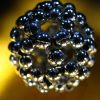An Elementary Guide to Magnetic Elements
Think back to high school science class. You probably spent a good amount of time learning and deciphering the periodic table of the elements. This nifty chart displays all the 118 natural and artificial materials that serve as the building blocks for all matter in the universe. It’s at this elemental level that substances gain their magnetism.
At Apex, we mostly deal with just a few elements known for their magnetic properties: neodymium, samarium, and cobalt. Here’s a brief primer on these elements that are crucial for the extra-strong products we sell.
Neodymium
Number 60 on your periodic table and part of the Lanthanide or Rare Earth group, neodymium (Nd) is at the core of most of our magnets. It was discovered in 1885 by Austrian scientist, Karl Auer, after he extracted it from its close relative, didymium. Neodymium is greek for “new twin,” so named for its relationship to didymium.
Neodymium started showing up in magnets around 1984. It’s most commonly found as an alloy with iron and boron. This alloy allowed manufacturers to shrink down many electronic devices such as speakers, cell phones, and computers. So, the reason we’re still not walking around with those giant car phones is partially because of neodymium. It can also be added to glass to add a purple or wine-red finish.
Samarium
Another element we see a lot is samarium (Sm). Atomic number 62, Samarium is another Lanthanide element. As its lower atomic number suggests, samarium was discovered before neodymium, in 1803. It’s name comes from the samarskite mineral from which it was first extracted.
While it has been slightly upstaged by more widely-used neodymium magnets, samarium can alloy with cobalt to form very powerful magnets. The benefit of samarium cobalt (SmCo) is their ability to maintain their magnetism at very high temperatures, which is why they are often found in microwave components.
Cobalt
Perhaps the most well-known of the elements we work with, cobalt (Co) is known for being a rather volatile substance. Atomic number 27, cobalt is a transition metal and has a wide array of uses. It has been found in glasswork and pottery dating back to ancient China and Egypt and has a beautiful metallic blue color. Like iron, cobalt can be magnetized and thus works very well when alloyed with samarium to make super-strong magnets.
Cobalt’s most infamous characteristic comes from its isotope, cobalt-60. This artificial concoction is highly radioactive and very harmful to humans. However, this particular kind of cobalt is not used in making magnets.
While these are the main elements we use to bring you some of the best magnets available, Apex also relies on others such as iron and boron. Knowing the right combinations and alloys ensures we provide the right magnet for the job, every time. Be sure to check out our full line of rare earth magnets!

